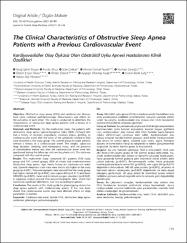| dc.contributor.author | Şahin Duyar, Sezgi | |
| dc.contributor.author | Aksu, Funda | |
| dc.contributor.author | Çilekar, Şule | |
| dc.contributor.author | Pazarlı, Ahmet Cemal | |
| dc.contributor.author | Sarıoğlu, Nurhan | |
| dc.contributor.author | Erçen Diken, Özlem | |
| dc.contributor.author | Öztürk, Önder | |
| dc.contributor.author | Altıntop Geçkil, Ayşegül | |
| dc.contributor.author | Berik Safçi, Sinem | |
| dc.contributor.author | Yılmazlı, Hakan Alp | |
| dc.date.accessioned | 2023-11-13T06:47:22Z | |
| dc.date.available | 2023-11-13T06:47:22Z | |
| dc.date.issued | 2022 | en_US |
| dc.identifier.citation | Duyar, S. Ş., Aksu, F., Çilekar, Ş., Pazarlı, A. C., Sarıoğlu, N., Diken, Ö. E., ... & Yılmazlı, H. A. (2022). The Clinical Characteristics of Obstructive Sleep Apnea Patients with a Previous Cardiovascular Event. Journal of Turkish Sleep Medicine, 9(2). | en_US |
| dc.identifier.issn | 2148-1504 | |
| dc.identifier.uri | https://dx.doi.org/ 10.4274/jtsm.galenos.2021.28199 | |
| dc.identifier.uri | https://hdl.handle.net/20.500.12933/1713 | |
| dc.description.abstract | Objective: Obstructive sleep apnea (OSA) and cardiovascular diseases have some common pathophysiologic characteristics and effects on the outcomes of each other. This study is conducted to determine the characteristics of obstructive sleep apnea patients with a history of a cardiovascular event. Materials and Methods: For this multicenter study, the patients with obstructive sleep apnea [apnea-hypopnea index (AHI) >5/hour] who had a history of coronary angioplasty, coronary bypass grafting, or cerebrovascular event after the onset of the symptoms related to OSA were recruited as the study group. The control group included patients without a history of a cardiovascular event. The weight, subjective sleep duration, smoking, and menopausal status, and the presence of comorbidities before and after the cardiovascular event were also questioned during the follow-up visits and by phone calls. This data was compared with the control group. Results: This multicenter study comprised 281 patients (100 study group and 181 control group), 83% of whom had moderate/severe obstructive sleep apnea. Age, family history for cardiovascular event and, Epworth sleepiness scale score were statistically higher in the study group (p<0.001). Polysomnographic data showed that the study group had higher central AHI (p=0.002), non-supine AHI (p=0.017) and lower NREM3% (p=0.001), mean and minimum oxygen saturation (p=0.002). A subgroup analysis proved that polysomnographic data, which had statistically significant differences, can vary according to gender. Conclusion: The results of this study guide for phenotyping obstructive sleep apnea patients with cardiovascular events. It has also been shown that cardiovascular events may have different effects on sleep parameters in women. | en_US |
| dc.language.iso | eng | en_US |
| dc.publisher | Erkan Mor | en_US |
| dc.relation.isversionof | 10.4274/jtsm.galenos.2021.28199 | en_US |
| dc.rights | info:eu-repo/semantics/openAccess | en_US |
| dc.title | The clinical characteristics of obstructive sleep apnea patients with a previous cardiovascular event | en_US |
| dc.type | article | en_US |
| dc.authorid | 0000-0001-8659-955X | en_US |
| dc.department | AFSÜ, Tıp Fakültesi, Cerrahi Tıp Bilimleri Bölümü, Göğüs Cerrahisi Ana Bilim Dalı | en_US |
| dc.contributor.institutionauthor | Çilekar, Şule | |
| dc.identifier.volume | 9 | en_US |
| dc.identifier.issue | 2 | en_US |
| dc.identifier.startpage | 139 | en_US |
| dc.identifier.endpage | 146 | en_US |
| dc.relation.journal | Türk Uyku Tıbbı Dergisi | en_US |
| dc.relation.publicationcategory | Makale - Ulusal Hakemli Dergi - Kurum Öğretim Elemanı | en_US |
















